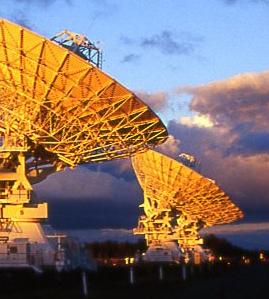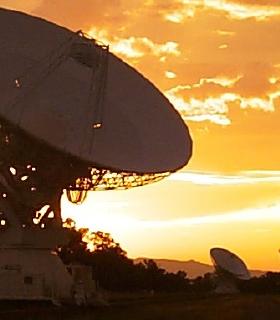 |
ATCA Science Day
Talk Abstracts
|
 |
Phil Edwards (ATNF)
"The Australia Telescope Compact Array: 20 years young"
An overview of the first 20 years of the ATCA will be given to set the scene for the following talks that focus on the next 5 years.
Baerbel Koribalski (ATNF)
"The ATCA in 2012"
It's July 2012 and many exciting events are happening around the world. Science with the ATCA from 1 - 115 GHz is booming; the northern spur has been extended to 500m. This is the era of ALMA & ASKAP as well as a few new space telescopes. Many discoveries have been made since 2008, some quite unexpected, ... but many old questions still remain unanswered. Flexible telescopes like the ATCA with CABB are in high demand, so are people with hands-on knowledge of interferometry. University linkage programs have be essential to continue upgrading ATCA, Mopra & Parkes.
John Dickey (University of Tasmania)
"The ATCA in the ALMA era, star formation tracers at cm-waves"
The Atacama Large Millimetre Array (ALMA) will dominate millimetre wave astronomy for the next two decades or more. The scientific monopoly of Australian radio telescopes over the Southern sky will be lost, and many of the problems currently best studied at cm-waves will then be much more easily undertaken at mm-waves with ALMA. The role of the ATCA, and to some extent of Parkes and the LBA, will shift in large part to support of Galactic and extra-galactic studies with ALMA. The ATCA and LBA will still be important, in some ways even more important than they are now, at least to overseas users. We can perhaps manage this new situation to our advantage if we prepare strategically.
Lister Staveley-Smith (University of Western Australia)
"Deep ATCA HI Surveys and the Path to ASKAP"
The Compact Array and Parkes telescopes have been a powerful combination for HI observations in the local Universe. However, the Compact Array has rarely been used for blind HI surveys due to its limited wideband spectral capability and its low mapping speed. With CABB on its way and the possibility of better low-frequency ATCA LNAs, the equation changes and ATCA will have some niche areas to work in before the advent of next-generation telescopes such as ASKAP, ATA-350 and the eVLA. I will describe some of the new science niches and the possibilities they create for testing observing and data reduction techniques that will become more common in the SKA and pathfinder era.
Kate Brooks (ATNF)
"Community outlook for Millimetre ATCA Projects"
The next decade is a bright one for astronomers observing in the millimetre and sub-millimetre wavebands. Around the world radio telescopes are sprucing themselves up in the countdown to early ALMA (2011) and full ALMA (2012+). Once ALMA is operational, it will offer unprecedented sensitivity, spectral-line coverage and imaging capabilities over the wavelength range 90 to 690 GHz. Astronomers will be queuing up to have their sources observed with ALMA, under the sign "no prior millimetre or interferometry experience necessary". This surge in community interest may drive up demand on existing facilities operating at the same wavebands, or it may leave them for dead. Whatever the effect, it will be acute for the millimetre wavebands of the Australia Telescope Compact Array, which shares its sky with ALMA. Whichever way you look at it, the next three years (dubbed the pre-ALMA era) will be a time of opportunity for existing radio telescopes operating at ALMA wavebands and for its users trying to get a look-in before ALMA does. Here I present a collection of slides from the mmATCA user community and some quotations from senior scientists driving current millimetre developments around the world. You will see their ideas for future ATCA projects in the pre-ALMA and ALMA era as well as their suggestions for new ATCA technologies.
Michael Burton (UNSW)
"Future Millimetre Capabilities - what Australia needs"
I will offer some thoughts as to future opportunities for millimetre-wave astronomy in Australia in the age of ALMA and ASKAP. In particular, I will ponder on how we might provide the capability of large scale mapping of the millimetre molecular sky, the facet most lacking from our current armoury of instrumentation.
Maria Cunningham (UNSW)
"Detecting New complex Organic Molecules in the Interstellar Medium"
Recent upgrades to the ATCA, such as the CABB and the 7-mm receiver system, mean that for the next several years, the ATCA will be the most powerful array telescope in the world for detecting new complex organic molecules. We have commenced a project to use the CABB to survey the Sgr B2 Large Molecular Heimat in the 3 and 7 mm bands at high spatial and velocity resolution, and the initial observations at 7-mm (with the old narrow-band system) have allowed us to confirm a detection of ethyl methyl ether about which there was previously some skepticism. The most powerful combination for detecting new molecules is an array combined with a sensitive single dish telescope, so the ATCA data will be combined with existing sensitive single dish surveys from the IRAM 30-m and GBT telescopes (through US and German collaborators), and with observations exploiting the broadband capabilities of Mopra. An important component in identifying new molecules is access to accurate measured transition frequencies and strengths, and we have this through collaboration with the interstellar chemistry group at Monash University.
Andrew Walsh (JCU), Henrik Beuther (MPIA), Steven Longmore (CfA)
"Massive accretion disks: ATCA's potential for deep impact"
Accretion disks around newly forming high mass stars are still yet to be observed in any detail. This is despite many attempts to image them across the electromagnetic spectrum. Recent theoretical work suggests part of the problem is that the disks and surrounding material may be optically thick at frequencies above about 100GHz. If this proves to be the case, ALMA may be of only limited use in characterising such disks.
Recent work at 25GHz with the ATCA has indicated that highly excited lines of ammonia may be used to peek through the surrounding material and see the disks. I will discuss this project and our plans to extend it with the ATCA, to observe more disk candidates. I will also talk about the potential for water vapour radiometers on the ATCA to make great impact in this field of research in the coming years.
Ilana Feain (ATNF)
"The formation and evolution of distant, massive, red, dead, active galaxies"
Galaxies in the distant universe were forming stars at a much higher rate than they are today. This could be due to more gas at high redshift or to a higher star formation efficiency, or both. Investigating the low excitation molecular gas phase in galaxies at high-redshift is therefore key to understanding the formation and evolution of galaxies. Studies of the low transition emission lines of CO will be key to these studies and, at high-redshifts, will be left to the cm instruments like ATCA and VLA/eVLA. Other higher density molecular gas tracers like HCN, HNC, HCO+ are also interesting and complimentary as they that pinpoint the sites of ongoing star formation. I will describe a niche for the ATCA in the field of redshifted molecular gas that will keep it at the forefront well into the ASKAP and ALMA eras. I will also propose some options for future upgrades.
Ron Ekers (ATNF)
"Detecting the Epoch of (Re-)Combination"
....
Bryan Gaensler (University of Sydney)
"Broadband Polarimetry with the ATCA"
The Faraday rotation of linearly polarised radio emission can be used as a powerful probe of the strength and geometry of magnetic fields in a whole range of foreground objects. However, our capability to measure Faraday rotation is strongly constrained by the experimental configuration. Specifically, the range of frequencies observed sets both the resolution in rotation measure (RM) space and the largest RM scale which can be detected. Amazingly, all current experiments have a largest RM scale that is smaller than the RM resolution! We are completely unable to "image" even the simplest structures in RM space, and so cannot meaningfully disentangle the complicated superposition of polarised structures that we see along most sightlines.
I will show how the CABB capability of the ATCA, combined with broadband upgrades to the L/S and C/X receivers, can move past these serious limitations, and can thus position the ATCA as the premier imaging facility for Faraday tomography. The resulting data-sets will provide the first 3D images of the magnetic field geometry in the ISM, in nearby galaxies, and in galaxy clusters.
Maxim Voronkov (ATNF)
"Maser Studies with ATCA"
In the past decade, the Australia Telescope Compact Array was a very successful instrument for maser research. The main reasons for this are the possibility to observe rest frequencies of some transitions, access to the southern sky and a reasonably good spectral resolution provided by the current correlator. Time availability also played a significant role (partially because of the bad instantaneous uv-coverage, long tracks were always requested) to make the southern surveys more substantial and systematic on average. The new Compact Array Broadband Backend (CABB) opens new opportunities and allows some new types of observations, which were impractical in the past. In the same time, EVLA upgrade makes the VLA a much more superior instrument for the northern sources. I will review the examples of maser science the Compact Array can do well and make suggestions for the further development of the hardware.
Tasso Tzioumis
"Science with the LBA"
....
Elaine Sadler
"AGN and galaxy evolution - the case for wide ATCA surveys"
Experience with the AT20G survey shows that the ATCA provides a fast, powerful and robust facility for imaging large areas of sky at high frequency. I will briefly describe the science case for high-frequency studies of AGN and galaxy evolution at flux levels below those probed by AT20G, and discuss some possible future large-area ATCA continuum surveys reaching to mJy levels over areas of hundreds of square degrees.
Andrew Hopkins
"The future of deep surveys with the ATCA"
I will give an overview of the areas and sensitivities achievable with the ATCA for potential wide and deep continuum surveys. While touching only briefly on possible key science drivers, I will compare possible ATCA surveys to several other surveys planned and proposed with other facilities (ASKAP, ALMA). I will highlight possible areas where ATCA may be able to provide significant complementary or even key primary data.
J-P Macquart
"Sgr A* & transient physics beyond the late naughties"
I will discuss the unambiguously unique role ATCA stands to play in transforming our understanding of the operation of the black hole at the Galactic Centre, Sgr A*, particularly at mm wavelengths. ATCA can also make a number of vital contributions to our understanding of the physics of several classes of radio transients.
Stuart Ryder (AAO)
"Radio monitoring of supernovae with ATCA + CABB"
I will review the major contributions already made by the ATCA to studies of the radio evolution of young core-collapse supernovae. Non-thermal emission generated in the forward shock as the blast wave plows up the circumstellar medium is a powerful probe of the mass-loss history of the progenitor star. CABB will vastly increase the pool of supernovae to monitor, as well as extend the time baseline for nearby supernovae and trace their mass-loss history even further back. It may even enable us to conclusively detect radio emission from Type Ia supernovae, and reveal the true nature of their progenitor systems.
Organisers
- Bärbel Koribalski(Baerbel.Koribalski AT csiro.au)
- Ilana Feain (Ilana.Feain AT csiro.au)
